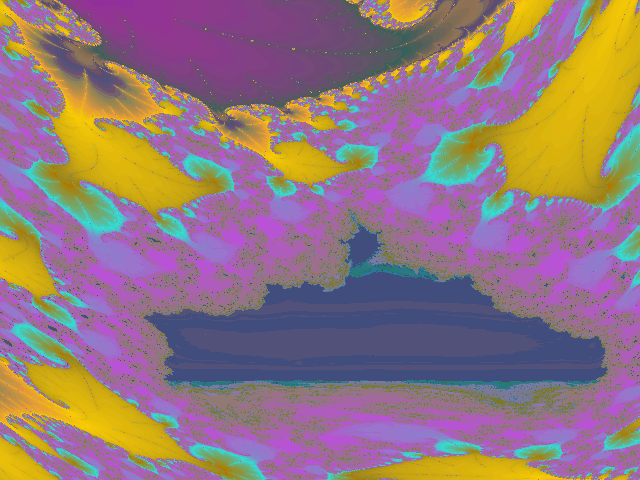

| October 5, 2011: The Flying Titanic | Oct. 4 | Oct. 6 | 2011 | FOTD Home |

Fractal
visionaries
and enthusiasts:
Today's image rates only a 4, hardly up to FOTD standards, but the
scene is so funny that I felt obliged to make it FOTD for
today. To me the scene shows the ghost of the long-lost ship
HMS 'Titanic', barely visible through the mists, sailing calmly over
some far-away heavenly sea. Unlike that other ghost ship, the
'Dutchman', a sighting of this ship does not portend
disaster. It is an omen of good fortune. The name
"The Flying Titanic" gives recognition to both ghost ships.
(Well, maybe the ship in today's image does resemble something more
like a small destroyer than a mighty ocean liner, but at least it's
something better than a tugboat.)
The scene is located in the East Valley area of the large minibrot on
the main stem of the Mandelbrot set. It is oriented in 4-D
space at an angle that would be impossible to describe, and is
stretched and skewed beyond imagining, yet here it is, a very
recognizable image of a ghostly ship passing silently in the night fog.
The image is an example of serendipity. When I stumbled upon
the hole that resembles a ship, I was searching for something entirely
different. I still am searching in fact, and if I find it, I
will make it tomorrow's FOTD.
Today's image finishes in 6-2/3 minutes, a little on the slow side for
a scene that rates an unusually humble 4. But this is where
the FOTD web site comes to the rescue.
The space of four dimensions, in which this month's featured fractal
object, the Julibrot, lies, is curious in many ways, especially when
compared to space of three dimensions. In 3-D space only five
regular polyhedrons, the five Platonic solids, are possible: the
tetrahedron, with four triangles as faces; the cube, with six squares
as faces; the octahedron, with eight triangles as faces; the
dodecahedron, with twelve pentagons as faces; and the icosahedron, with
twenty triangles as faces.
And in space of five dimensions as well as spaces of all higher
dimensions, the increasing numbers of lower dimensional elements
usually do not match up correctly, and only three regular figures now
called polytopes are possible. These are the analogs of the
tetrahedron, cube and octahedron. So what about space of four
dimensions?
Intuition suggests that also in 4-D space, only three regular polytopes
are possible, just as in spaces of all higher dimensions. But
in this case intuition is wrong. In space of four dimensions,
where the polytopes are bounded by three-dimensional boundaries called
cells, six regular polytopes are
possible: the hyper-tetrahedron, bounded by five tetrahedrons; the
hyper-cube, (sometimes called the tesseract), bounded by eight cubes;
the hyper-octahedron, bounded by sixteen tetrahedrons; the
hyper-dodecahedron, bounded by 120 dodecahedrons; and the
hyper-icosahedron, bounded by 600 tetrahedrons. There is also
a figure bounded by 24 octahedrons, which has no regular analog in 3-D
space, but is related to the semi-regular rhombic dodecahedron.
So what would life be like in 4-D space, living on a hyperspherical
planet most likely subject to a dizzying double rotation?
Would the stars in the 3-D sky trace out helixes?
Unfortunately, no such planet would be possible. In 4-D space
the force of gravity would obey an inverse-cube law, making stable
planetary orbits impossible. A planet would either quickly
spiral into its star or sail off into interstellar space. So
much for fantasy.
The weather here at Fractal Central today was certainly no
fantasy. We enjoyed cloudless skies and a temperature of 70F
21C. The fractal cats, now settling into winter mode, found
comfort on their shelf in the sunny southwest window.
The humans, FL and I, found comfort in the bright sunlight streaming
through the windows, which has been pretty scarce the past couple
months. Even more comfort will be found when the next FOTD is
found and delivered, hopefully in 24 hours. Until then, take
care, and the formula for the hypervolome of a five-dimensional
hypersphere is 8/15*(pi^2)(r^5). Let me know when this
useless bit of information might become important.
Jim Muth
jimmuth@earthlink.net
START PARAMETER FILE=======================================
The_Flying_Titanic { ; time=0:06:39.42-SF5 on P4-2000
reset=2004 type=formula formulafile=basicer.frm
formulaname=SliceJulibrot2 passes=1
center-mag=-0.00048410686492484/+0.089235490629652\
03/262770.2/0.00651/-90/89.1258940753795486
params=30/90/0/90/-1.7489/0/0/0 float=y
maxiter=4200 inside=atan logmap=206 periodicity=6
colors=000GJV_5W_AZ_Ca_Ca_D`_D`_D_ZEZZEZYFYXFYWGXW\
GWVGWUHVTHVTIUSITRITRJSQJSPKROKQOLQNLPMLPLMOLMNKNN\
JNMDONFOMHOMJNMLOMNOMPPMRPMTQLVRLXRLZSL_SLXTMUPORK\
QMJSKKUNKTQKSTOQWTOZWMaXKdYJgYIjZHk_Hm`Gp`FsaEtbDt\
cDtcCtdBueAue9uf9vg8vh7vh6wi5wj5wk4xk3xl2xm1xm1wl2\
wl2vk2vk2uk2uj2tj2tj3si3si3rh3rh3qh3qg3pg3pg4of4of\
4ne4ne4me4md4md4ld5lc5kc5kc5jb5jb5ia5ia6ha6h`6g`6g\
`6f_6f_6eZ6eZ7dZ7dY7cY7cY7bX7bX7fU0dW4bX7`ZAZ_EY`H\
WbKUcOSeRQfUPgYNi`LjcJlgHmjBsnDqmEpmGnmHmmIkmKjmLi\
mMgmOfmPdmRcmSbmT`mV_mWYmXXmZVm_UmaTmbRmcQmeOmfNmi\
KphLohLngMmgMlgMkfNjfNifNheOgeOgeOfdPedPddPccQbcQa\
bR`bR_bR_aSZaSYaSX`TW`TV`TU_UT_US_USZUXYUaYUfXU`XU\
WWUQWULVUFUUAUU5UUAUUFUUKUUPUUUUUVUUWUUXUUYUUZUU_U\
U`UUaUUbUUcUUdUUdUUcUUbUUaUU`FU`EU_DUZCUYBUYAUXAUW\
AUVAUVAUTAUSAURAUPAUOAUNAUMAUPAUSAUVAUYAU`AUcAUeAU\
cAUbAUaAU`AU_AUZAUXAUdAUd }
frm:SliceJulibrot2 {; draws most slices of Julibrot
pix=pixel, u=real(pix), v=imag(pix),
a=pi*real(p1*0.0055555555555556),
b=pi*imag(p1*0.0055555555555556),
g=pi*real(p2*0.0055555555555556),
d=pi*imag(p2*0.0055555555555556),
ca=cos(a), cb=cos(b), sb=sin(b), cg=cos(g),
sg=sin(g), cd=cos(d), sd=sin(d),
p=u*cg*cd-v*(ca*sb*sg*cd+ca*cb*sd),
q=u*cg*sd+v*(ca*cb*cd-ca*sb*sg*sd),
r=u*sg+v*ca*sb*cg, s=v*sin(a),
c=p+flip(q)+p3, z=r+flip(s)+p4:
z=sqr(z)+c
|z|<=9 }
END PARAMETER FILE=========================================